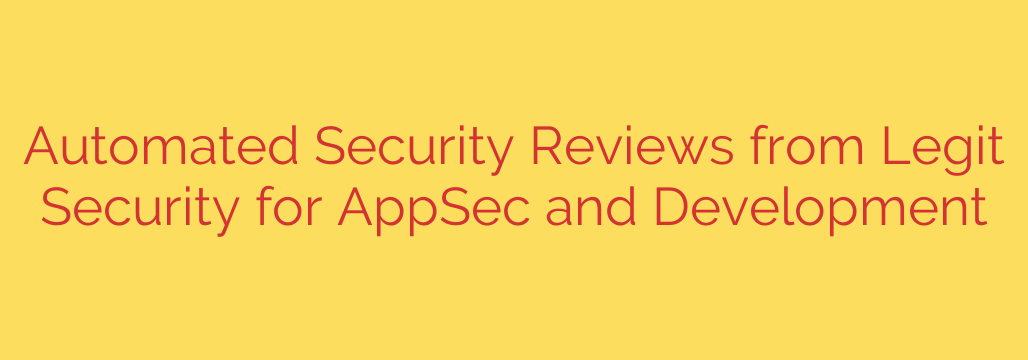
Automate Your Security Reviews: Bridge the Gap Between Speed and Safety
In today’s fast-paced world of software development, speed is everything. Teams operate in agile sprints, pushing code through CI/CD pipelines at a relentless pace to deliver new features and maintain a competitive edge. But where does security fit into this high-speed lifecycle?
Too often, application security (AppSec) is seen as a roadblock. Traditional security reviews are manual, time-consuming processes that can bring a swift development cycle to a grinding halt. This creates friction between developers, who are focused on innovation, and security teams, who are tasked with protecting the organization. The result is a difficult choice: slow down development or accept a higher level of risk.
Fortunately, there’s a better way. By shifting from manual spot-checks to automated security reviews integrated directly into the software development lifecycle (SDLC), organizations can achieve both speed and robust security.
The High Cost of Traditional Security Reviews
The old model of security reviews is fundamentally incompatible with modern DevOps and agile methodologies. It typically involves a security analyst manually reviewing code, architecture, and configurations at the end of a development cycle.
This approach is plagued with problems:
- It creates bottlenecks: Developers are forced to wait for security approval, delaying releases.
- It lacks context: Security teams often provide long lists of potential vulnerabilities without prioritizing them based on real-world risk or business impact.
- It fosters frustration: Developers receive feedback too late in the process, forcing them to re-work code that was considered “finished,” leading to inefficiency and resentment.
This friction means security is often perceived as the “department of no,” hindering progress rather than enabling safe innovation.
A Modern Approach: Integrating Security into the Workflow
Automated security reviews fundamentally change this dynamic. Instead of being a final gatekeeper, security becomes an ongoing, automated process embedded within the tools developers already use.
Think of it as a vigilant, automated security expert that provides real-time feedback throughout the entire SDLC. From the moment a developer commits code to its final deployment in the cloud, security checks are running seamlessly in the background.
Key Benefits of Automating Your Security Reviews
Adopting an automated framework isn’t just about finding vulnerabilities faster; it’s about building a more resilient, efficient, and collaborative development culture.
Eliminate Manual Bottlenecks and Accelerate Development
By integrating security scans directly into the CI/CD pipeline, feedback is delivered in minutes, not days or weeks. Developers are notified of potential issues directly in their environment, allowing them to fix problems immediately while the context is still fresh in their minds. This continuous loop prevents security from becoming a last-minute emergency.Gain Context-Aware, Actionable Insights
Effective security isn’t just about finding every possible flaw. It’s about understanding which flaws matter. Automated systems can analyze the entire development ecosystem, connecting pieces of information to determine the true risk of a vulnerability. Instead of a generic list of CVEs, you get prioritized alerts that consider how the code is built, what sensitive data it accesses, and whether it’s exposed to the internet.Foster Collaboration Between Development and Security
When security insights are delivered automatically and with clear context, the adversarial relationship between developers and security teams dissolves. Both teams can work from a shared, trusted source of information, breaking down silos and focusing on the common goal of shipping secure, high-quality software. Security becomes a shared responsibility, not a delegated task.Secure Your Entire Software Development Lifecycle (SDLC)
Application risk doesn’t just live in your source code. It can be introduced through misconfigured build scripts, exposed secrets in infrastructure-as-code files, or vulnerabilities in third-party dependencies. A comprehensive automated security platform provides visibility across your entire SDLC, from code repositories and CI/CD systems to container registries and cloud environments.
Actionable Steps to Get Started
Implementing an automated security review process is a foundational step toward a mature DevSecOps posture. Here are a few practical tips to guide your implementation:
- Integrate Seamlessly: Choose solutions that integrate with your existing toolchain, including Git, Jenkins, Jira, and your preferred code scanners. The goal is to enhance developer workflows, not replace them.
- Define Smart Policies: Implement “policy-as-code” to automatically enforce your organization’s security standards. These policies can check for everything from hardcoded secrets to insecure dependencies and ensure consistency across all projects.
- Prioritize Ruthlessly: Focus your team’s attention on the risks that pose the greatest threat to your business. An effective automated system should help you cut through the noise and highlight the critical vulnerabilities that need immediate attention.
By embedding automated security reviews into the heart of your development process, you can finally resolve the conflict between speed and safety. This allows your teams to innovate confidently, knowing that security is an integrated enabler of progress, not a barrier to it.
Source: https://www.helpnetsecurity.com/2025/07/17/legit-security-developers-capabilities/








